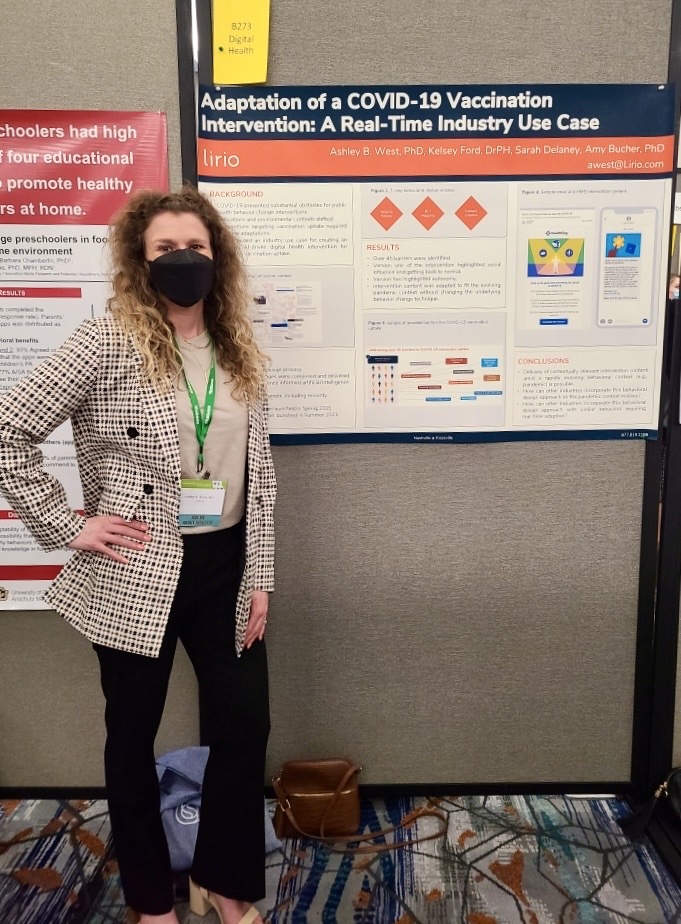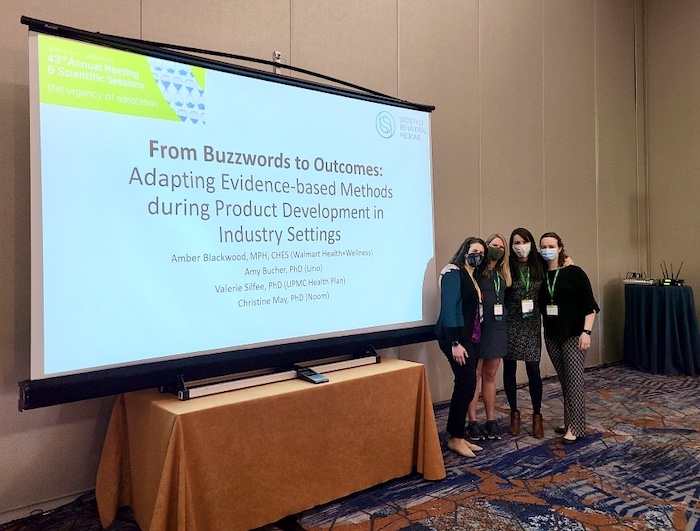Earlier this spring, members of Lirio’s Behavioral Science team participated in the Society of Behavioral Medicine’s 43rd Annual Meeting and Scientific Sessions. This year’s theme was “The Urgency of Adaptation,” which stemmed from the opportunities for behavioral medicine to increase its impact while our world confronts three major public health tragedies: the climate crisis, systemic racism, and the COVID-19 pandemic.
Our team of academically trained behavioral science experts delivered several presentations on various BeSci topics and how they apply to the Lirio platform while engaging with the many innovative practices and perspectives shared across industry and academia. Here are 3 of the major themes that emerged from our time there and in the follow-up since.

3 Themes Moving Us Forward
Behavioral Science in Industry
Behavioral science plays an integral role in numerous industries. According to a recent survey released in 2021 by the National Science Foundation, the number of psychologists earning doctorates and entering academia has dropped by 7% over the past 10 years. The report also found that the percentage of graduates entering the industry or business sectors has increased by nearly 10%.
SBM is a professional home to many industry behavioral scientists who work in big pharma, big tech, and smaller digital startups. This creates support for, and interest in, how to do rigorous and meaningful work outside of academia in a way that is scalable and designed for dissemination. The interest from all levels was evident in the number of events highlighting the conversation, including the symposium From Buzzwords to Outcomes: Adapting Evidence-based Methods During Product Development in Industry Settings.
This symposium, featuring Lirio’s Chief Behavioral Officer Amy Bucher, Ph.D. as a co-presenter, concentrated on this recent surge in applications of behavioral scientific knowledge outside of standard education settings. The session focused on adapting behavioral science techniques for product development and highlighted the challenges faced and methods used in developing digital health products. Standard industry settings pose unique challenges such as aligning vision with business priorities, balancing evidence with market demand during feature prioritization, and communicating value to non-scientific audiences.
Amy’s presentation focused on best practices for integrating behavioral scientists into larger departmental teams. The presentation first focused on the trade-offs that behavioral scientists must consider in choosing the type of role and organization that best fits their career goals, including the availability of mentorship and the depth of science being practiced. Then, based on her experience in the tech and product spaces, Amy shared best practices for applying behavioral science in different types of organizations, such as selecting models and frameworks that are accessible to laypeople and figuring out an elevator pitch. Implementing these best practices will facilitate effective cross-functional collaboration, which allows an organization to adopt a human-centered behavioral design approach to their products or platforms.
Amy and Director of Behavioral Design Kelsey Ford, DrPH, also participated in a networking session designed to give prospective job seekers insights into applied behavioral science roles through conversations with experienced behavioral scientists. While the number of these opportunities is disproportionately low, the industry is recognizing the competitive advantage they bring. In an intensely crowded healthcare market, behavioral scientists generate differentiation through increased engagement and effectiveness—not only through the end result, but in the process and collaboration that influence equity, access, and impact.
Evolve and Adapt
As indicated by this year’s theme, there are ever-increasing opportunities to drive positive change through behavioral science. Realizing that potential, however, requires addressing internal and external challenges. In addition to recognizing the value industry brings, there is a need for more diversity in the technologies and approaches that are resourced.
Industry-driven applications can generate more cross-discipline collaboration and a shift into more modern and inclusive conceptual models for behavior change. Without having to rely on grant funding that may favor a singular behavioral theory, behavioral science teams can be more responsive in using ideas from many theories and taxonomies. Other opportunities arise in academic-industry partnerships; Behavioral Medicine sees the value in AI, Machine Learning, and Predictive Analytics but often researchers aren’t equipped with robust teams to do this type of sophisticated analytics.
This capacity to engage more broadly and efficiently is the only way to meet the challenges of a rapidly evolving public health environment and the long-overdue focus on health equity, which has moved from a niche concern to top of mind for both academic researchers and scientists in industry. Health equity is an important factor in today’s healthcare landscape, as disparities of all kinds have long kept people from realizing the same standard of care. Last year, The Commonwealth Fund released a health equity scorecard that broke down how health systems across the country are trying to address equitable care for people of color.
The team explored the many ways that health equity can be promoted by bringing attention to critical issues, like improving the implementation of digital health technologies to yield high uptake, engagement, and sustainment. Becoming aware of and catering to groups with varying social determinants of health can help break down individual, community, and institutional barriers to provide better healthcare for all.
High-Impact Healthy Behavior Change
Behavior change plays a large role in the wider discussion of public health. Analysts say that to influence public opinion and participation in large-scale health movements, it’s essential to understand the science behind human behavior, even as federal funding for social and behavioral sciences continues to represent only a small fraction of what’s needed. At SBM 2022, several of our Lirio team members shared presentations and abstracts that studied how behavioral science can drive high-impact healthy behavior change.
Lirio Senior Behavioral Designer Ashley B. West, Ph.D., first presented the abstract Adaptation of a COVID-19 Vaccination Intervention: A Real-Time Industry Use-Case. Co-authored by West, Ph.D., Kelsey Ford, DrPH, Sarah Delaney, and Amy Bucher, Ph.D., this poster shared how Lirio’s behavioral designers identified over 45 barriers to vaccine hesitancy and developed a Precision Nudging™ solution to help address them.
Using this intervention, Lirio’s team was able to discern how vaccine-hesitant individuals process and respond to critical vaccine information. The team concluded that the delivery of contextually relevant intervention content amid a rapidly evolving behavioral context (e.g., a pandemic) is possible and quantifiable.
In the session Real-world Iterations: A Case Study of a Mammography Digital Health Intervention, Kelsey presented from the paper of the same name co-authored by Ford, DrPH, Susanne Blazek, Ph.D., Amy Bucher, Ph.D., Chandra Osborn, Ph.D., and Chris Symons, Ph.D. Kelsey shared the adaptation of an intervention using artificial intelligence to compile behavioral science-based health communications in promoting mammograms. After launching in 2020, the team had to adapt in real-time when the pandemic demanded an updated approach to account for new barriers and behavior change techniques.
Enhancements and changes to the intervention involved understanding the state of the science, recognizing evolving barriers, dialing in potent behavior change theories, reducing the library size, and adjusting the tone and visuals. The findings were noteworthy – despite the pandemic, mammogram attendance improved with the revised intervention above and beyond pre-COVID19 attended mammograms.
By bracing for real-world implications and being open to adapting active interventions despite conventional wisdom, the team was able to deliver real-world change. Effectively influencing behavior change to drive better health outcomes, particularly amid a larger tension between science and culture, requires doing interventions in a way that is adaptable and realistic.

What Else is Possible?
SBM 2022 was a timely conversation highlighting the pivotal role of behavioral science in the current healthcare transformation. Our team welcomed the chance to learn from innovators in the field and share the success of Lirio’s approach in driving significant behavior change.
Interested in learning more about Precision Nudging interventions and how behavior science drives healthy patient engagement? Check out our recent webinar To Segmentation and Beyond: Hyper-Personalizing Your Patient Engagement Ecosystem, featuring Lirio Chief Behavioral Officer Amy Bucher.
